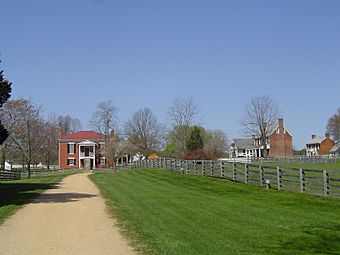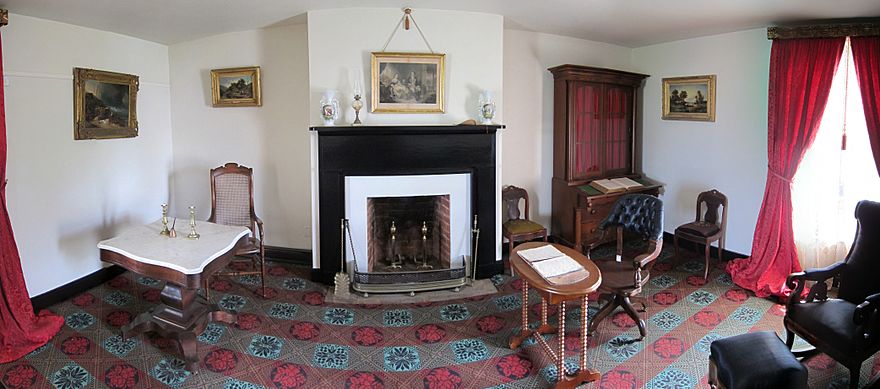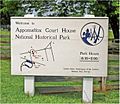Appomattox Court House National Historical Park facts for kids
|
Appomattox Court House National Historical Park
|
|

Appomattox Court House National Historical Park. The Old Appomattox Court House is at left; the reconstructed McLean House, the site of the formal surrender, is at right.
|
|
| Location | Appomattox County, Virginia |
|---|---|
| Nearest city | Appomattox, Virginia |
| Area | 1,774.6 acres (718.2 ha) |
| Visitation | 92,650 (2021) |
| Website | Appomattox Court House National Historical Park |
| NRHP reference No. | 66000827 |
Quick facts for kids Significant dates |
|
| Added to NRHP | October 15, 1966 |
The Appomattox Court House National Historical Park is a special place in Appomattox County, Virginia. It protects a 19th-century village called Appomattox Court House. This village is famous because it was the site of a very important event in American history.
Here, in April 1865, the American Civil War effectively ended. General Robert E. Lee, who led the Confederate Army, surrendered to General Ulysses S. Grant, the Union commander. This happened at the McLean House within the village.
The village started as a small community called Clover Hill. It became the county seat for Appomattox County in the 1840s. However, when a railroad was built nearby in 1854, bypassing the village, it began to decline.
Later, in 1930, the U.S. government decided to protect this historic site. The National Park Service took over in 1933. They made the park much bigger in 1935. After World War II, the McLean House was rebuilt and opened to visitors in 1949. Today, you can see several restored buildings, like the McLean House and the old courthouse, along with some original 19th-century structures.
Contents
The Village Before the War
Before the Civil War, the village was known as "Clover Hill." It was a busy stop on the main road between Richmond and Lynchburg. When Appomattox County was created in 1845, Clover Hill became its main town, or county seat. The county was named after the Appomattox River, which got its name from a Native American tribe called Apumetec.
In the 1840s, land in Clover Hill was divided into lots for building. The state set aside land for government buildings. The courthouse was built across from the Clover Hill Tavern.
However, in 1854, a new railroad line was built. It went through a different area, which became known as Appomattox Depot. Many businesses moved from Appomattox Court House to the new railroad town. The old stagecoach route also stopped coming through the village. This caused Appomattox Court House to become much smaller and quieter.
The Civil War and Its Aftermath
In early April 1865, the American Civil War was nearing its end. General Robert E. Lee and his Confederate troops were being chased by Union Army forces led by Ulysses S. Grant. Lee's army was trapped near Appomattox Court House.
On April 9, Lee's troops tried one last attack in the Battle of Appomattox Court House, but they were not successful. That same day, General Lee met with General Grant at the McLean House. They talked about the terms of surrender.
Lee signed the surrender papers that day. Three days later, on April 12, the Confederate Army of Northern Virginia officially laid down their weapons. They then marched away. Even though the war continued in other places for a short time, the surrender at Appomattox Court House is seen as the moment the Confederacy was defeated.
The end of the war did not help the village. In 1892, the county's records were destroyed in a courthouse fire. Because of this, it was decided to move the county seat to the railroad town of Appomattox Depot. This town then became known simply as Appomattox.
How the Park Was Developed
After the courthouse burned down in 1892, and the McLean House was taken apart, people realized the village was falling apart. In 1930, the U.S. Congress decided to buy land at the village. They wanted to create a monument to the 1865 surrender.
Three years later, in 1933, the land was given to the National Park Service. In 1935, the site's name was changed to "Appomattox Court House National Historical Monument." The park was also made larger, and plans were made to rebuild the McLean House. The name changed again in 1954 to "Appomattox Court House National Historical Park."
By 1940, the park grew to about 970 acres (390 ha). Plans to rebuild both the courthouse and the McLean House were set. However, World War II caused delays. Finally, in 1949, the rebuilt McLean House was opened to the public.
On October 15, 1966, the park was officially added to the National Register of Historic Places. The National Park Service has since restored the village. Many original 19th-century buildings, like the Clover Hill Tavern, are still there.
Today, the park covers about 1,700 acres (690 ha). It has both original and rebuilt historic buildings, including the famous McLean House. Visitors can explore the park using driving tours and hiking trails. Along the trails, you'll find signs explaining the history, the spot where Lee's headquarters were, and an area with old cannons. The park's visitor center is located in the rebuilt courthouse.
Images for kids
See also










